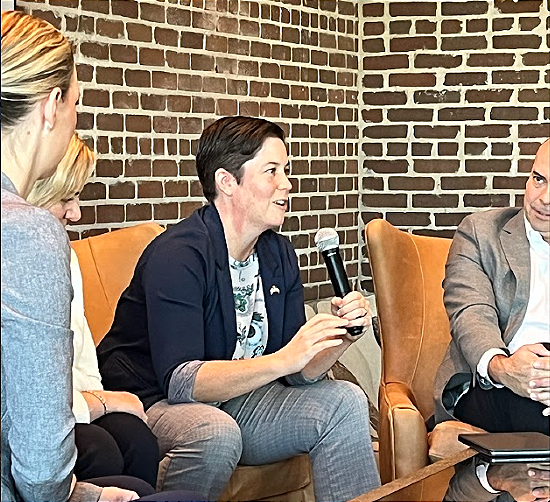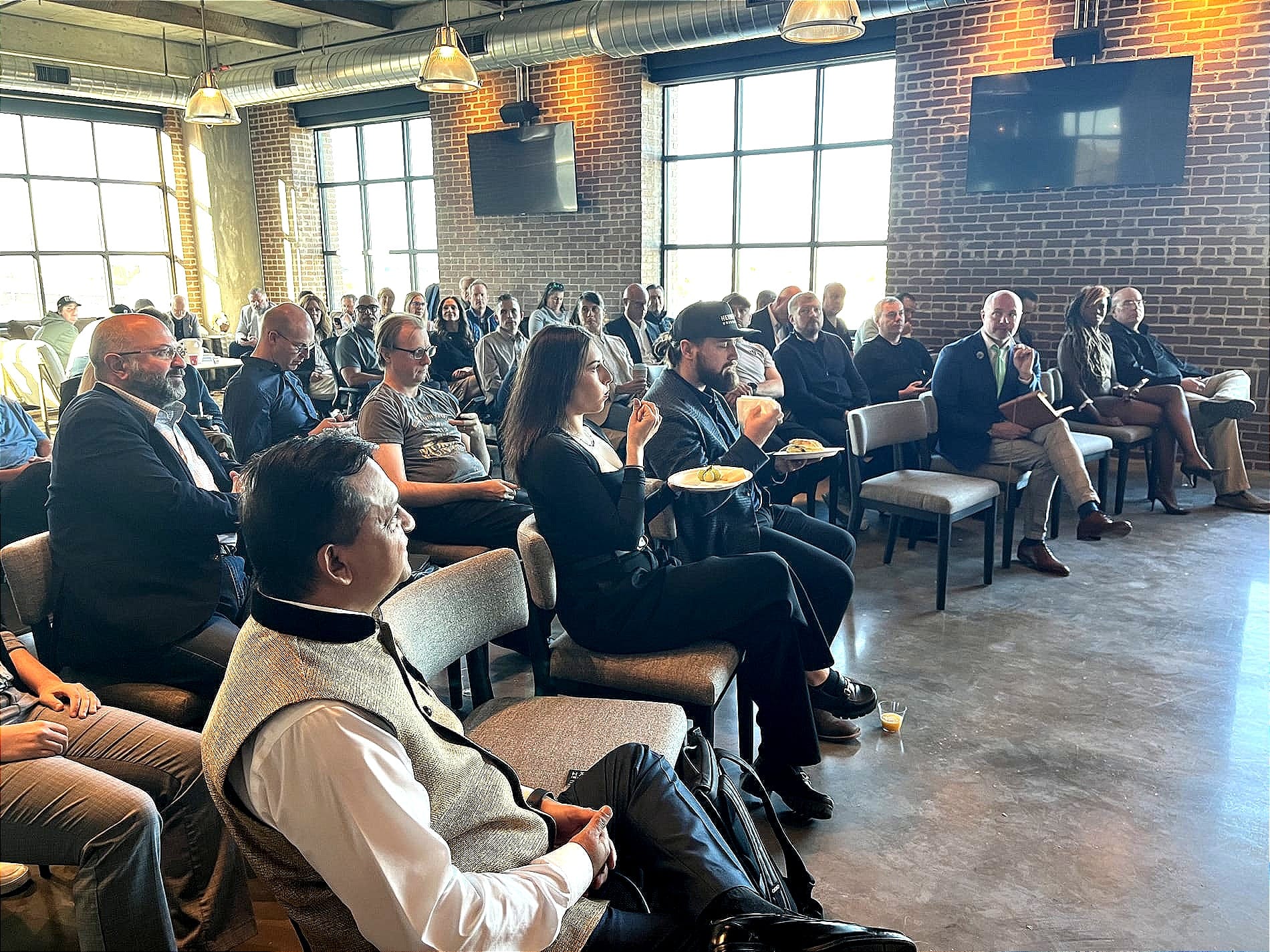

Salt Lake City, Utah — October 31, 2025
On October 30, KolobX convened 70 industry leaders, innovators, and educators in downtown Salt Lake City for Powering Futures — Advanced Manufacturing & Next-Gen Leadership, an event focused on empowering the next generation of builders, engineers, and manufacturers.
The event brought together key stakeholders across Utah’s manufacturing and aerospace ecosystem — including small businesses, large corporations, educators, and students — to explore workforce development, technology adoption, and collaborative innovation.

Leaders from Northstar Photonics, 47G, and Utah Manufacturers Association explored the opportunities and challenges shaping this next-generation workforce.
A Small State with Big Potential
Utah’s small size is both an advantage and a challenge. Caroline Chapdelaine, CEO of Northstar Photonics, noted that “we can reach out to just about anyone in the state very easily — get the help we need, find the suppliers we need, or recruit people for our workforce. That gets me excited as a business owner, but it also scares me because there’s not a huge workforce to tap into when I expand.”
Chapdelaine highlighted Utah’s tight-knit business culture and growing ecosystem: “We have such a wonderful culture here. As we bring outsiders in, we can show them the Utah way and integrate them into what is a very nice, tight-knit family.” She emphasized the role of local universities, such as Utah State University and the University of Utah, in supporting workforce development through specialized labs and hands-on collaboration.
Johnny Ferry, President and CEO of Utah Manufacturers Association, added perspective on scale: “Many think of manufacturing as just a building with smoke stacks, but that’s only the primary manufacturer. In Utah, there are over 5,000 registered primary manufacturing businesses. But the broader ecosystem — including supply chain, R&D, distribution, warehousing, quality, and regulatory compliance — encompasses more than 85,000 registered businesses. That’s where Utah’s GDP and economic impact really come from.”

Modern Jobs in a High-Tech Landscape
The manufacturing workforce has been transformed by technology. Kori Ann Edwards, Chief Strategy Officer of 47G, said that “AI, robotics, and automation have created entirely new roles. Instead of performing manual tasks, people are now managing machines, analyzing data, and solving complex problems. This attracts a new kind of talent, elevates wages, and makes manufacturing much more engaging than it was before.”
Ferry illustrated this with a concrete example: “A chocolate company from San Francisco needed a new technology to produce single-serve packets. By partnering with the state and securing a grant, we brought the technology to Utah and trained local staff. The machines now produce 250–300 packets per minute. Not only did we land the business, but the ripple effects benefit employees and consumers alike.”
Chapdelaine added, “If students and young professionals can see the impact of their work — that they make a difference — they’re more likely to want to enter the field.”

Connecting Students to Industry
Programs that expose students to the industry are central to workforce development. Edwards described several statewide initiatives: “Talent Ready Utah bridges industry with the Utah System of Higher Education. It ensures companies are connected to the skills students are learning. We also have Pathways programs for internships in aerospace, defense, and manufacturing, and K–12 computer science initiatives to get kids excited early.”
Events like next week's 47G’s Zero Gravity Summit bring these initiatives to life. Edwards explained, “We’re inviting 1,000 students — 700 college students and 700 high school students — to participate. Every university can send 75 students at no cost. The goal is exposure and inspiration, showing students that manufacturing is high-tech, creative, and impactful.”
Ferry highlighted inclusivity: “We recently participated in a program for students on the autism spectrum interested in manufacturing. Many roles are repetitive and structured — ideal for a range of skills. Grants are available to support manufacturers who want to participate, giving these students meaningful pathways into the workforce.”
Chapdelaine also stressed creativity as a critical skill: “Creative people thrive in this industry. They like to see something go from nothing to something. Exposure and hands-on experience are key to attracting the next generation.”

Bridging Gaps in Collaboration
Despite its strengths, Utah’s ecosystem faces challenges connecting small businesses with large corporations. Chapdelaine observed, “As small business owners, we know how to stick together and support each other. The state does a great job with programs, and 47G has built a strong ecosystem. But bridging the gap between small businesses and companies like Boeing or Northrop is hard. They live in DC and often forget that their supply chain depends on us.”
Edwards emphasized participation: “There are many programs and opportunities, but if you’re not involved, that’s the gap. Join advisory boards at tech colleges, engage with associations like UAMMI or 47G, and make sure your voice is heard. Institutions can adapt quickly to meet industry needs, but only if businesses participate.”
Ferry also highlighted opportunity in the broader ecosystem: “The scale of Utah manufacturing is immense. You can work anywhere in the ecosystem — supply chain, R&D, operations, distribution — and you’re part of manufacturing. But the more businesses collaborate, the stronger the ecosystem becomes.”

State Support and Forward Momentum
State programs have been central to Utah’s manufacturing resurgence. Edwards and Ferry cited initiatives such as the Modern Manufacturing Nation grants, R&D tax credits, and Talent Ready Utah, which provide both financial incentives and structured pipelines to prepare the workforce.
Edwards concluded, “The state is being very intentional. With these programs, students get exposure, businesses get skilled employees, and the ecosystem grows stronger every year.”
Utah’s manufacturing sector is at a crossroads of technology, talent, and collaboration. Chapdelaine said it best: “If anyone can solve the challenge of connecting small businesses to big corporations consistently, it would be transformative for Utah’s manufacturing ecosystem.”
In response to Chapdelaine’s insight, KolobX is actively pursuing frameworks to bridge this critical gap, linking innovation to scale.
Founded by Jakob Noble in 2025 and headquartered in Lehi, Utah, KolobX is a Global Strategic Intelligence & Integration Firm. It curates tactical engagements and implements actionable solutions that advance integrated operations across industries and regions. The organization also forms working groups focused on energy & grid innovation, municipal deployment strategy, infrastructure policy & permitting, and youth & workforce engagement. Katherine Gottfredson is a key collaborator and advisor.
The organization also pilots strategic partnerships with municipalities, tech companies, and global development leaders, creating opportunities for participants to move beyond panels and shape real-world outcomes.

More information about Zero Gravity Summit:
47G | Utah Aerospace & Defense is set to host the 2025 Zero Gravity Summit, large gatherings focused on the future of national security, defense innovation, aerospace, energy resilience and advanced air mobility systems. The two-day summit will take place on Tuesday, Nov. 4 – Wednesday, Nov. 5, 2025. It will convene leaders at the Salt Palace in downtown Salt Lake City from the Department of Defense, major aerospace companies, startup founders, investors, energy innovators and policymakers to discuss emerging technologies that are transforming how the U.S. leads on the global stage.
Register at zerogravitysummit.com
Salt Palace Convention Center | 100 S.W. Temple St., Salt Lake City, UT 84101
Speakers will include:
- Spencer Cox, State of Utah Governor
- Jen Easterly, former Director of the Cybersecurity and Infrastructure Security Agency (CISA)
- Nikki Haley, former U.S. Ambassador to the United Nations and Governor of South Carolina
- Dmytro Kushneruk, Consul General of Ukraine
- Peyton Manning, NFL Hall of Famer and entrepreneur
- Aaron Starks, 47G President and CEO
- Brad Wilson, CEO of Salt Lake City-Utah 2034 Olympic and Paralympic Games
Read about TechBuzz' coverage of last year's inaugural 2024 Zero Gravity Summit.

